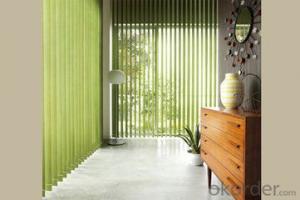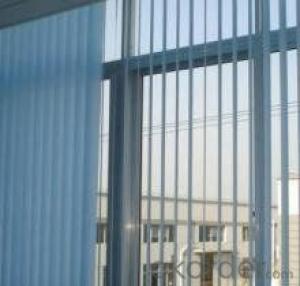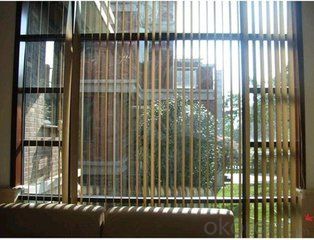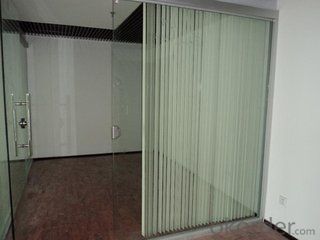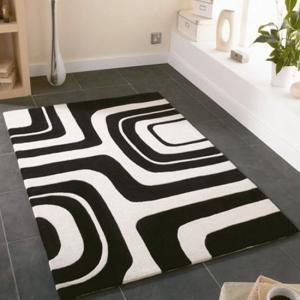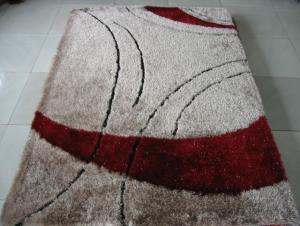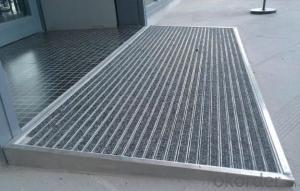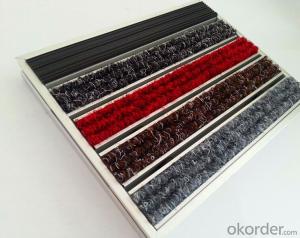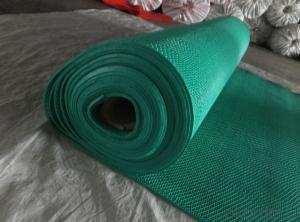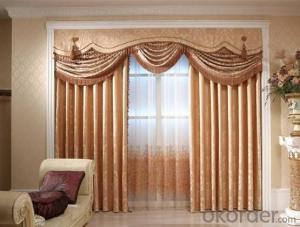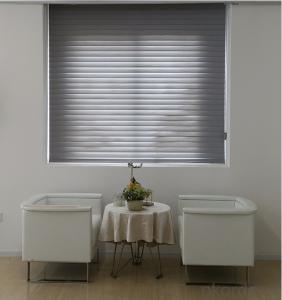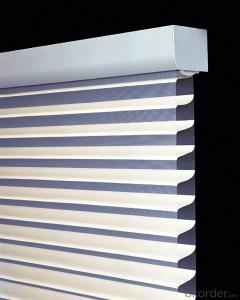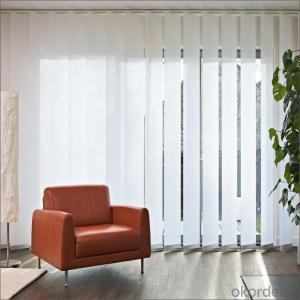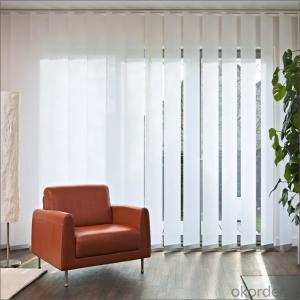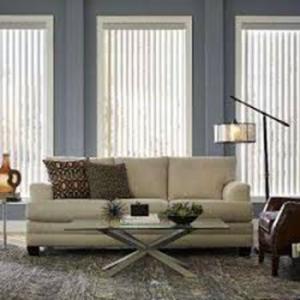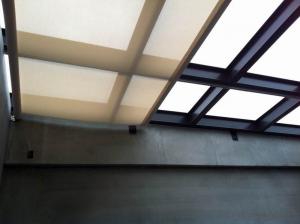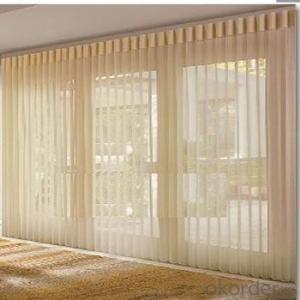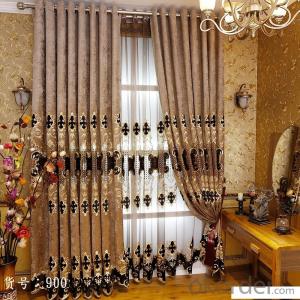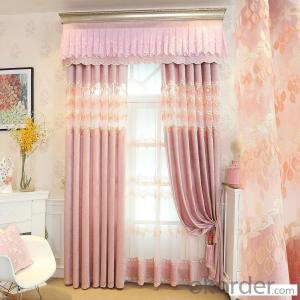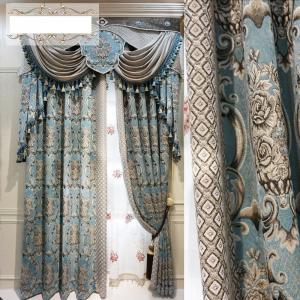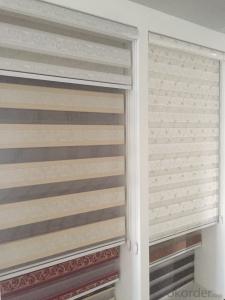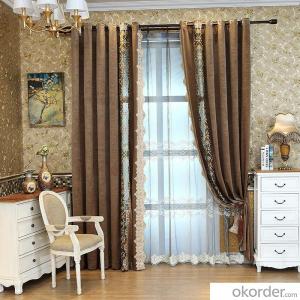vertical curtain for door shading design
- Loading Port:
- Ningbo
- Payment Terms:
- TT OR LC
- Min Order Qty:
- 1000 m
- Supply Capability:
- 10000 m/month
OKorder Service Pledge
OKorder Financial Service
You Might Also Like
Product Description
1) The aluminum alloy tube is 28mm or 38mm diameter in the anodic oxidation treatment surface and smooth pvc plug-in unit.
2) The fabric is no need to be sewed and the fittings is scientific and rational logistic, with the function of anti-skidding and auto-lock in the operating process.
Features
1.We can make any requirements in design, pattern, color and size;
2.We can make customer's logo on the surface of products;
3.The dimention tolerance of our products is controled within 0.03mm;
4.Our products are child safety, pet safety and environment-friendly;
5.Our products are exported to America, Europe, India, west Asia,etc., and conforms to the standard test.
Specifications
Model | TB-XF |
Location | Window |
Colour vailable | custom |
usage | home,office,cafe,ect. |
MOQ | 10 sets |
Delivery time | About 20 days after 30% deposit |
Payment terms | L/C, T/T,Paypal |
Packing | Carton |
Pictures
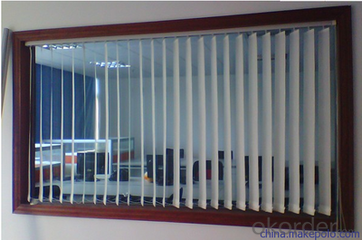
FAQ
1.Q:Are you factory or trading company?
A:We are professional manufacturer for 20 years.
2.Q:Where is your factory?
A:Our factory is located in Shaoxing which near Keqiao.
3.Q:Do you sell curtain fabric or ready made curtain?
A:We do both.
4.Q:What kind of products do you make?
A:Embroidery, printing,burnout,jacquard,blackout.
5.Q:How many designers in your company?
A:5 professional designs.
6.Q:Do you provide free samples?
A:Yes.
- Q: What are the best curtains for a tropical living room?
- The best curtains for a tropical living room would be lightweight and made from natural materials such as cotton or linen. Opt for curtains in vibrant colors and tropical patterns such as palm leaves, floral prints, or exotic animals to bring a touch of the tropics into your living space. Sheer curtains are also a great option as they allow natural light to filter through while providing privacy. Additionally, consider choosing curtains with a tie-back feature to create a breezy and relaxed atmosphere. Ultimately, the best curtains for a tropical living room are those that capture the essence of the tropics and complement the overall theme and decor of the space.
- Q: Can curtains be used to create a sense of elegance in a room?
- Yes, curtains can definitely be used to create a sense of elegance in a room. Curtains not only serve a functional purpose by providing privacy and controlling light, but they also add a decorative element to any space. By choosing the right fabric, color, and design, curtains can instantly transform the ambiance of a room and add a touch of sophistication and elegance. For instance, heavy, floor-to-ceiling curtains made of luxurious fabrics like silk or velvet can create a grand and opulent atmosphere, reminiscent of traditional and formal settings. On the other hand, sheer or lightweight curtains made of materials like chiffon or lace can bring a sense of delicacy and gracefulness to a room, particularly in a more modern or romantic style. Additionally, the way curtains are hung and styled can further enhance the sense of elegance. Using ornate curtain rods, finials, and tiebacks can elevate the overall appearance and lend a refined touch. Moreover, layering curtains with other window treatments like blinds or shades can add depth and richness to the space. In summary, curtains have the power to create a sense of elegance in a room through their choice of fabric, color, design, and the way they are hung. By carefully selecting and styling curtains, one can effortlessly enhance the overall aesthetic and elevate the sophistication of any space.
- Q: What are the standard curtain sizes?
- Different brands and styles can result in variations in standard curtain sizes. However, there are common dimensions that are widely found. Most standard windows can be accommodated by curtain lengths of 63 inches, 84 inches, 95 inches, and 108 inches. It is crucial to accurately measure your windows before purchasing curtains to ensure a proper fit. When it comes to width, standard curtain panels are typically available in widths of 42 inches, 54 inches, or 84 inches. Panels can be added or removed to achieve the desired fullness. Some manufacturers also offer custom sizing options for non-standard window sizes. If you are unsure about available standard sizes or require a custom fit, it is advisable to consult the specific brand's sizing guide or seek professional advice.
- Q: Can curtains be used to create a sense of airiness in a small space?
- Yes, curtains can definitely be used to create a sense of airiness in a small space. By choosing lightweight and sheer fabrics, such as voile or linen, curtains can allow natural light to filter through while still maintaining privacy. Opting for light colors like white or pastels can also help to reflect light, making the space feel brighter and more open. Hanging the curtains higher and wider than the window frame can give the illusion of taller ceilings and a larger space. Additionally, using floor-length curtains that gently touch the floor can add a touch of elegance and create a sense of height. Overall, curtains can be a versatile and effective tool in making a small space feel more open, airy, and inviting.
- Q: Can I use curtains to create a vibrant and eclectic room?
- Yes, you can definitely use curtains to create a vibrant and eclectic room. Curtains play a significant role in enhancing the overall aesthetics of a space, and with the right choice of colors, patterns, and materials, you can easily achieve a vibrant and eclectic look. To create a vibrant room, opt for curtains in bold and bright colors such as red, orange, yellow, or even a combination of multiple colors. These vibrant hues will instantly add energy and liveliness to the room. Additionally, consider incorporating patterns like geometric shapes, florals, or abstract designs to further enhance the eclectic feel. In terms of materials, look for curtains made from rich and textured fabrics like velvet, silk, or even tapestry. These materials not only add depth to the room but also contribute to the eclectic ambiance. Mixing and matching different fabrics can also create an interesting contrast and add to the overall eclectic vibe. To complete the vibrant and eclectic look, consider layering curtains or adding additional elements such as tassels, trims, or beaded accents. These details can further enhance the visual interest and make the room truly unique. Remember, the key to creating a vibrant and eclectic room using curtains is to embrace boldness, play with colors and patterns, and mix different textures and materials. By doing so, you can transform your space into a visually stimulating and captivating environment.
- Q: What are the best curtains for a Scandinavian-inspired bedroom?
- The best curtains for a Scandinavian-inspired bedroom would be light and airy options such as sheer or linen curtains in neutral colors like white, beige, or light gray. These curtains allow natural light to flow into the room, creating a bright and inviting atmosphere, while also maintaining the minimalist and clean aesthetic of Scandinavian design.
- Q: How do I hang curtains on a hospital or medical facility?
- In regards to hanging curtains in a hospital or medical facility, there are several important factors to consider. Here are the steps you can take: 1. Evaluate the space: Begin by assessing the area where you intend to hang the curtains. Measure the dimensions of the windows or doorways to determine the appropriate curtain size. 2. Choose suitable curtains: Select curtains that meet the specific requirements of a medical facility. Opt for durable materials that are easy to clean and preferably have antimicrobial properties to maintain a hygienic environment. Consider curtains with a fire-retardant coating for added safety. 3. Install curtain tracks or rods: Depending on the facility's layout, you can choose between curtain tracks or rods for installation. Curtain tracks are a popular choice as they offer a smooth and effortless gliding mechanism for the curtains. Ensure that the tracks or rods are securely attached to the walls or ceiling using appropriate hardware. 4. Measure and cut the curtains: Measure the height of the curtain tracks or rods, allowing for a slight overlap at the bottom for privacy. Cut the curtains to the desired length, leaving some extra fabric for hemming and any necessary adjustments. 5. Hem the curtains: If needed, hem the curtains to the appropriate length using a sewing machine or fabric adhesive. Ensure that the hems are secure and tidy to prevent fraying. 6. Hang the curtains: Slide the curtain hooks or rings onto the curtain tracks or rods, evenly distributing them for a balanced appearance. Attach the curtains to the hooks or rings, ensuring they are securely fastened. 7. Adjust and level: Once the curtains are hung, adjust them to ensure they are level and evenly positioned. Smooth out any wrinkles or creases for a polished and professional look. 8. Test functionality: Test the curtains by opening and closing them to ensure they glide smoothly along the tracks or rods. Make any necessary adjustments to the hooks or rings for optimal functionality. If you are unsure about installing curtains in a hospital or medical facility, it is advisable to seek guidance from a professional experienced in healthcare facility design or maintenance. They can provide additional assistance and ensure the curtains are installed safely and effectively.
- Q: How do I hang curtains on a TV or film production set?
- To effectively hang curtains on a TV or film production set, careful planning and attention to detail are necessary. Follow these steps for optimal results: 1. Determine the purpose: Begin by identifying the specific purpose for hanging curtains on the set. Will they block light, create a backdrop, or enhance aesthetics? This will help you select the appropriate type, size, and material for the curtains. 2. Measure and mark: Accurately measure the area where the curtains will be placed using a measuring tape. Mark the desired positions for curtain rods or hooks on the walls or ceiling. 3. Select the right hardware: Consider the weight and size of the curtains when choosing the appropriate hardware. Tension rods or adhesive hooks may suffice for lightweight curtains, while brackets, rods, or tracks securely attached to the walls or ceiling are suitable for heavier curtains. 4. Install the hardware: Follow the manufacturer's instructions to properly install the selected hardware. Ensure that the brackets or rods are level and securely mounted. If using tracks, ensure proper alignment and attachment. 5. Attach the curtains: Depending on the type of hardware, attach the curtains using curtain rings, hooks, or by sliding them directly onto the rods or tracks. Ensure that the curtains hang straight and are evenly spread. 6. Adjust and secure: Step back and evaluate the placement of the curtains. Make any necessary adjustments to ensure alignment and visual appeal. If necessary, use clips, ties, or fasteners to secure the curtains in place and prevent unwanted movement during filming. 7. Test lighting and camera angles: Before finalizing the curtain setup, test the lighting and camera angles to ensure that the curtains serve their intended purpose without causing unwanted shadows or reflections on the set or actors. Remember to adapt these steps to suit your specific requirements, as each production set is unique. Additionally, seek assistance from experienced set designers or crew members to ensure a professional and seamless curtain installation.
- Q: Can curtains be used to create a sense of nostalgia in a room?
- Certainly, one can utilize curtains to effectively cultivate a nostalgic atmosphere within a room. Nostalgia, often associated with a yearning for the past and the evocation of memories from a specific time or era, can be readily achieved through the meticulous selection of curtains that reflect a particular style or period. This enables the room and its inhabitants to effortlessly journey back in time. For instance, the utilization of sheer lace curtains instantaneously conjures a nostalgic ambiance reminiscent of the Victorian or Edwardian eras. These delicate and intricate curtains, which were highly favored during those periods, can elicit a sense of grace and romance, serving as a reminder of a bygone age. Similarly, the choice of curtains adorned with vintage floral patterns or retro designs can instantaneously transport a room to the 1950s or 1960s, thereby creating a nostalgic atmosphere. These patterns were immensely popular during those decades and can effectively recreate the visual and sensory experience of that specific time. Furthermore, the selection of fabric can significantly contribute to the creation of a nostalgic ambiance. Opting for heavier materials such as velvet or damask can evoke a sense of classic charm, reminiscent of grand old houses or vintage movie theaters. Moreover, the color palette employed for the curtains can play a pivotal role in cultivating a nostalgic atmosphere. Warm and earthy tones, such as deep reds, browns, or mustard yellows, can effectively evoke nostalgia by invoking vintage aesthetics. In summary, curtains possess the capability to serve as a potent tool in generating a sense of nostalgia within a room. Through the careful consideration of style, fabric, pattern, and color, one can effortlessly transport the room and its occupants back in time, allowing them to relive and experience the nostalgia associated with a particular era.
- Q: Can curtains be used to create a sense of privacy in an apartment?
- Certainly, the utilization of curtains in an apartment can effectively establish a feeling of privacy. By installing curtains on windows or in specific areas of the apartment, they can effectively obstruct the external view, preventing any peering eyes from glimpsing the interior. This can prove particularly advantageous in densely populated urban regions or on lower levels where passersby can easily peer into the apartment. Curtains serve as a tangible barrier, granting individuals the ability to regulate the level of visibility into their living space, thereby instilling a sense of seclusion and privacy. Furthermore, curtains also possess the capacity to diminish external noise, further enhancing privacy by fostering a serene and private atmosphere within the apartment.
Send your message to us
vertical curtain for door shading design
- Loading Port:
- Ningbo
- Payment Terms:
- TT OR LC
- Min Order Qty:
- 1000 m
- Supply Capability:
- 10000 m/month
OKorder Service Pledge
OKorder Financial Service
Similar products
Hot products
Hot Searches
Related keywords
